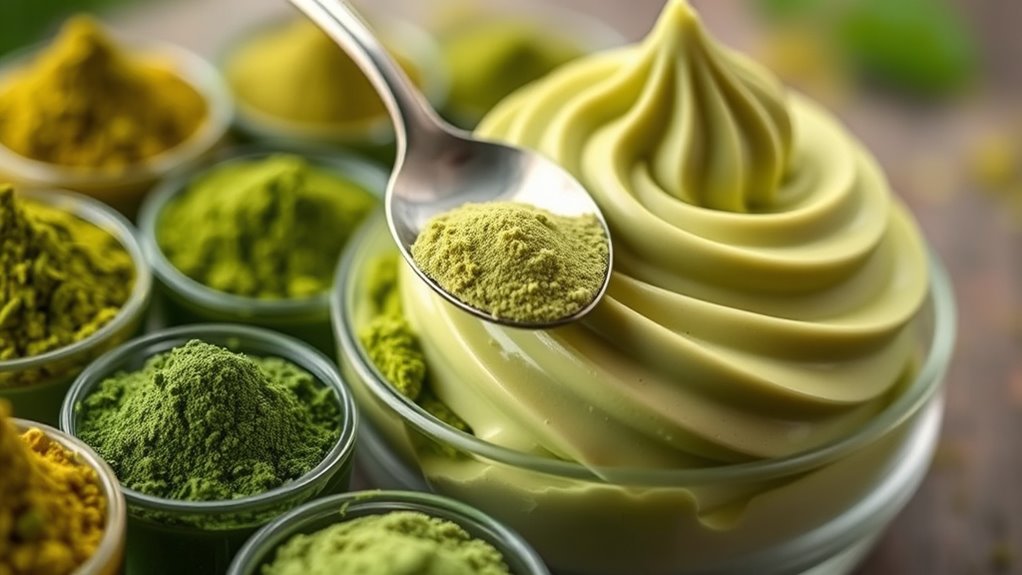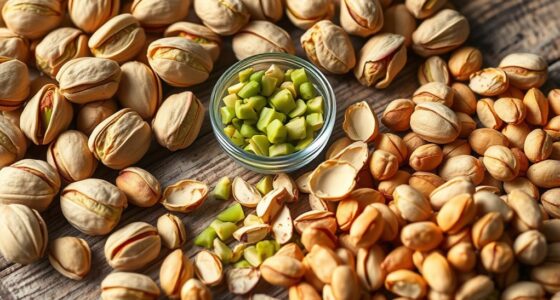Choosing the right matcha grade greatly affects your gelato’s flavor, color, and aroma. High-quality, shade-grown matcha offers a smooth, balanced, and vibrant flavor, perfect for refined treats. Mid-grade matcha provides a bolder taste with some bitterness, while lower grades can be more astringent and dull. Knowing these differences helps you craft delicious, well-balanced gelato. Keep exploring to uncover how each grade shapes your perfect matcha dessert.
Key Takeaways
- Different matcha grades offer distinct flavor profiles, affecting gelato’s taste, aroma, and overall quality.
- High-grade matcha, produced through shading, provides a vibrant color and smooth, umami-rich flavor ideal for refined gelato.
- Mid-grade matcha has a stronger, slightly bitter flavor, suitable for bolder gelato styles or recipes with added ingredients.
- Lower-grade matcha tends to be more astringent and dull, often used when flavor is secondary or masked in desserts.
- Selecting the appropriate matcha grade enhances gelato’s flavor balance, appearance, and consumer appeal.

When choosing matcha for gelato, understanding the different grades is essential because each offers distinct flavor profiles and quality levels. The grade you select influences the taste, aroma, and overall quality of your final product. High-grade matcha typically comes from specific harvesting methods that prioritize quality, such as shading the tea plants before harvest. This shading process increases chlorophyll and amino acids, resulting in a vibrant green color and a richer, more umami flavor. Conversely, lower-grade matcha is often made from leaves harvested without such special techniques, which can lead to a more bitter or astringent taste. Recognizing these harvesting methods helps you determine the suitability of a matcha for gelato, where a delicate balance of sweetness and earthiness is desired.
Flavor profiles vary considerably across matcha grades, and understanding these nuances allows you to craft gelato with the perfect taste. Premium matcha tends to have a smooth, mellow sweetness, complemented by grassy and umami notes, making it ideal for creating a refined, balanced gelato. Mid-grade matcha might have a more robust flavor with hints of bitterness, which can be appealing if balanced with sugar or other ingredients. Lower-grade matcha often features a more astringent, dull flavor that might be less desirable in fine desserts but could work in recipes where strong matcha flavor is secondary or masked.
Frequently Asked Questions
How Do Matcha Grades Influence Gelato Texture?
When you choose different matcha grades, it directly affects the gelato texture. Higher-quality matcha powder blends smoothly into the gelato cream, creating a velvety, rich consistency. Lower grades might cause a grainier texture or uneven mixing. You’ll notice that premium matcha integrates seamlessly, giving your gelato a luxurious mouthfeel, while lower grades may leave your gelato feeling rough or gritty. So, the grade of matcha truly shapes your final dessert’s texture.
Are Higher-Grade Matchas More Environmentally Sustainable?
You might wonder if higher-grade matchas are more eco-friendly. Generally, they often come from farms practicing eco-friendly farming methods and hold organic certifications, which support sustainability. These matchas are usually produced with fewer pesticides and chemicals, reducing environmental impact. So, choosing higher-grade matcha can align with your values for sustainability, supporting organic farming practices that protect the environment and promote healthier ecosystems.
Can Lower-Grade Matcha Be Used for High-Quality Gelato?
Imagine scooping velvety gelato, the vibrant green hinting at rich, earthy flavors. You might wonder if lower-grade matcha, often cheaper in the matcha price comparison, can still deliver that high-quality taste. While traditional matcha offers nuanced layers, culinary-grade matcha can work in gelato, but it may lack the depth of premium varieties. For the best flavor, opt for higher grades, especially when aiming for authentic, refined results.
What Is the Shelf Life of Different Matcha Grades in Gelato?
You should know that the shelf life of different matcha grades in gelato depends on storage conditions and flavor stability. Properly stored in an airtight container, kept away from light and moisture, high-quality matcha can last up to six months, while lower grades may last around three months. To maintain ideal flavor, always monitor for signs of oxidation or loss of aroma, which indicate it’s time to replace your matcha.
Do Matcha Grades Affect Gelato’s Nutritional Content?
You might wonder if matcha grades influence gelato’s nutritional content. Generally, higher-quality matcha contains more antioxidants and nutrients, offering greater health benefits. Lower grades may have slightly fewer nutritional differences but still contribute beneficial compounds. So, choosing a better grade can enhance your gelato’s health benefits, providing more antioxidants and nutrients. Ultimately, the matcha grade affects the nutritional differences and health benefits present in your delicious gelato treat.
Conclusion
So, don’t let the variety of matcha grades overwhelm you. Choosing a higher grade might seem costly, but it truly elevates your gelato’s flavor and quality. Remember, the right matcha isn’t just about appearance—it’s about taste and aroma. Even if you’re on a budget, experimenting with mid-grade options can still delight your palate. Trust your senses and enjoy crafting gelato that’s rich, vibrant, and unforgettable.









